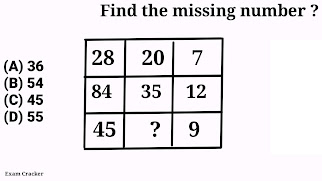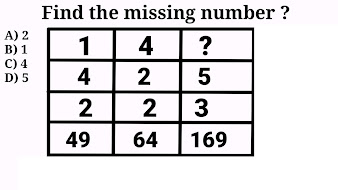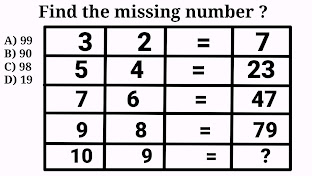Twelve Most Important figures problems of Reasoning analogy part 3
Discussed most Important Reasoning analogy problems and frequently asked picture problems in previous competitive examinations along with their answers .
Post your answer in comments and to confirm your answer click here. |
Twelve Most Important figures problems of Reasoning analogy
Problem # 1
Outermost numbers are the product of Square roots of two numbers attached to it.
Since 14 is attached with 4 and 49 , the square root of 4 and 49 are 2 and 7 respectively now multiplying 2 and 7 to get 14.
Since 12 is attached
with 36 and 4 , the square root of 36 and 4 are 6 and 2 respectively now multiplying 6 and 2 to get 12.
So 30 must be the product of Square Root of 36 and ? , so if we put 25 instead of Question Mark ? .Then product of square root of 25 and the square root of 36 which will be equal to 30.
Similarly product of square root of 49 and Square Root of ? must be equal to 35 . But we had already put 25 in place of ? to give product 35 .
Hence (b) 25 is right option.
Problem # 2
( 3 х 2 ) - 1 = 6 - 1 = 5
Multiplying 5 with 2 and subtracting 2 from result so obtained to get 8.
( 5 х 2 ) - 2 = 10 - 2 = 8
Multiplying 8 with 2 and subtracting 3 from it to get 13.
( 8 х 2 ) - 3 = 16 - 3 = 13
Now multiplying 13 with 2 and then subtracting 4 from result so obtained to get 22.
( 13 х 2 ) - 4 = 26 - 4 = 22
At last multiplying 22 with 2 then subtracting 5 from the result so obtained to get 39 .
( 22 х 2 ) - 5 = 44 - 5 = 39.
so (C) 39 is the right answer
Problem # 3
1st Step
In 1st Row B ,D are F are written in a gap of one letter .
In 3rd Row N ,P and R are written in a gap of one letter
In 2nd Row H and J are also written in a gap of one letter ,So J and ? must be written with a gap of one letter .This means after J the Lett with one gap will be L.
2nd Step
In 1st row digits associated are 3 ,3 and 6 means last digit in the Row is sum of 1st two digits 3 + 3 = 6.
In 3rd row digits associated are 7 ,9 and 16 means last digit/number in this Row is sum of 1st two digits 7 + 9 = 16.
In 2nd row digits associated are 5 ,6 and ? will be replaced by sum of other two digits 5 + 6 = 11 .
So (a) L11 is the right option
Problem # 4
Here in this Figure result will be calculated column wise in any particular column. In first column the fourth element is calculated by dividing second element with third element and then multiplying first and the results will be obtained.
1st column
(12 ÷ 3) × 18 = 72
3rd column
(16 ÷ 4) × 32 = 72
2nd column
(14 ÷ ?) × 16 = 112
⇒ 14 ÷ ? = 112 ÷ 16
⇒ 14 ÷ ? = 7
⇒ ? = 2
Therefore option ( A )2 is right answer .
Problem # 5
Add all the numbers in any particular figure and then subtract 2 from it to get the middle number .
In 1st figure we have 0 + 6 + 4 + 2 = 12 minus 2 = 10 { middle number in 1st figure}
In 2nd figure 6 + 2 + 10 + 8 = 26 - 2 = 24 { middle number in 2nd figure} .
Similarly In 3rd figure we have 4 + 14 + 12 + 10 = 40 - 2 = 38 ( Question Mark ) which is our required number.
Therefore option ( C ) is right answer .
Want to check more reasoning problems with their solutions ,click here,.
Problem # 6
If we add all the numbers column wise then we get 99 in all the three columns so we shall have 42 in place of question mark to have total 99 in all the three columns .
Because 40 + 24 + 35 = 99 ( Last number in 1st column )
In second column we have 30 + 35 + 34 = 99 ,(Last number in 2nd column ) . While in last column when we add ? + 30 + 27 ,then the sum of all the numbers in last column will be 99 so required number will be 42.
The right option is ( a) 42
Problem # 7
Find the sum of numbers which are in the Row ( horizontal ) then subtract this total from the sum which are in column ( vertical ) to find the number which is in the middle of the given figure .
In 1st figure 5 + 6 is equal to 11 and 4 + 7 which is also equal to 11 so difference of both the sum is equal to zero ,which is the middle number in 1st figure.
(5 + 6 ) - ( 4 +7 ) = 11 - 11 = 0
In 2nd figure 7 + 6 is equal to 13 and 8+ 4 which is equal to 12 so difference of both the sum is equal to 1,which is the middle number
(7 + 6) - ( 8 +4 ) = 13 - 12 = 1
In 3rd figure 11 + 2 is equal to 13 and 0 + 2 which is equal to 2 so difference of both the sum is equal to 13 - 0 = 11 which will be in the middle number.
(11 + 2) - ( 0 +2 ) = 13 - 2 = 11
Correct option is 3(11)
Problem # 8
Multiplying all the elements in 2nd row with 2 then add elements of 1st and 2nd row downward to get the elements in 3rd row
1st Column 13 + ( 7×2 ) = 13 + 14 = 27
2nd Column 54 + ( 45 × 2 ) = 54 + 90 = 144
3rd Column ? + ( 2× 32 ) = 68
This implies ? = 68 - 64 = 4
So the correct option is A(4)
Problem # 9
To find the middle number in each figure add all the numbers except middle number then divide it with 4 to get middle number .
In figure 1st add 24 + 32 + 40 + 36 = 132 which when divided by 4 gives 33
In figure 2nd add the numbers 27 +19 + 20 + 22 = 88 Which when divided by 4 gives 22
similarly in 3rd figure when we add all the numbers 6 + 16 + 14 + 1 2 = 48 which will after division by 4 gives 12 .
So option ( 2 )12 is correct option
Problem # 10
Sum of all the digits of 1st and 2nd rows are 17 .Similarly sum of all digits of 3rd row must be 4 +7 + ? = 17 .This implies the value of ? should be 6.
Hence the correct option will be ( a ) 6
Problem # 11
Spilt this circle into two parts ,one above x axis and other below x axis , the sum of digits in both the semi circle must be equal to each other .
This means ? + 4 + 5 + 6 = 11 + 9 + 3+7
? +15 = 30
? = 15
So option ( 4 ) 15 will be right option
Problem # 12
This pattern consists of two series of alternative numbers ,first one consists of 2, 4, 8, 16,32 so on and second series consists of the number 6, 9, 13, 18, so on .
So our next number in from given series will be derived from the second series 6, 9, 13, 18, so on .
Look at the difference between first two number 6 and 9 which is equal to 3 ,And difference between second number (9) and third number (13 ) is 4 And difference between third number ( 13 ) and fourth number ( 18 ) is 5 so difference between 18 and next number must be 6 it means next number must be 24 because 24 - 18 = 6
Show the correct option is (1)24
How-to-Solve-hard-and-impossible-Puzzles
FINAL WORDS
Thanks for watching and responding to this post of Twelve most Important Reasoning Analogy questions with answers and how to solve missing number problem. If you want any improvement in it please do write to us in comment section.
Appeal
If you are a mathematician Don't forget to visit my Mathematics You tube channel ,Mathematics Website and Mathematics Facebook Page , whose links are given below
Also watch this video
If square root of any number is added /subtracted infinite time ,then what will be the answers .









































